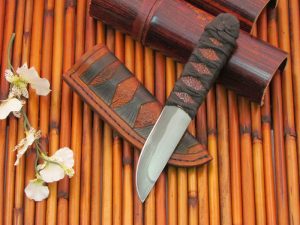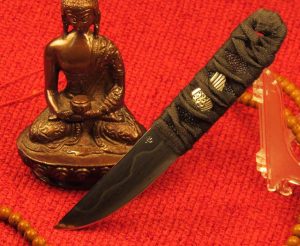 The kwaiken is like a dagger. It’s a type of small tanto, historically carried by both men and women of the samurai class. As with the tetsu no bo (kanabo), I’m having a hard time finding a reliable translation. Kwaiken literally translates to “chest knife” or “bosom knife,” but whether or not the literal translation carries the intended meaning isn’t clear to me just yet. Because it was carried in the obi, and the obi (especially on a woman) was worn on the lower chest and upper abdomen, I think the meaning is probably literal.
The kwaiken is like a dagger. It’s a type of small tanto, historically carried by both men and women of the samurai class. As with the tetsu no bo (kanabo), I’m having a hard time finding a reliable translation. Kwaiken literally translates to “chest knife” or “bosom knife,” but whether or not the literal translation carries the intended meaning isn’t clear to me just yet. Because it was carried in the obi, and the obi (especially on a woman) was worn on the lower chest and upper abdomen, I think the meaning is probably literal.
The traditional kwaiken has a wooden handle and saya (sheath)—very much like a shirasaya tanto—but was substantially smaller. The modern westernized version usually has a wrapped handle, which is more traditional for a full-sized sword. The sheath is often Kydex or Concealex, but I personally prefer leather…
It’s More Stabby than Cutty
Like most daggers and related knives, the kwaiken is intended more for stabbing than cutting although it does have a curved blade that makes it a fairly good cutter if the geometry is correct. While any well-made kwaiken works well for self-defense, I consider them to be primarily art knives.
It’s a Nice Palette for the Bladesmith
The blade, by its very nature, is simple and elegant. It’s small—only 6–9 in. overall—and easy to either forge or grind. The only real options are whether to have a curved or straight spine. The blade is wide enough to hold a decent-sized hamon, and the handle is large enough to allow for some creative maki (wrapping), underlay (traditionally it’s stingray skin, but I use leather, copper sheet, and whatever else looks good), and menuki (handle charms). The menuki are a good opportunity to give the blade a “personality” if you use it in game. I have recently been using raptor wing menuki, but it’s common to see bats, spiders, dragons, snakes, lizards, fish, and flowers.
How I Make One
 First, the blade is profiled, and the bevels are created by either forging or grinding. Hardening and tempering are next, followed by finish grinding and polishing. If the blade is to be etched or blued, that comes next, followed by the application of whatever underlay is being used, the menuki, and finally the wrap. The wrap is held in place and hardened with epoxy. Although not traditional, the epoxy is necessary because the small handle on this knife lacks the fittings and furniture that help hold the wrap in place on a full-sized sword. Finally comes sharpening and signing the blade with my maker’s mark.
First, the blade is profiled, and the bevels are created by either forging or grinding. Hardening and tempering are next, followed by finish grinding and polishing. If the blade is to be etched or blued, that comes next, followed by the application of whatever underlay is being used, the menuki, and finally the wrap. The wrap is held in place and hardened with epoxy. Although not traditional, the epoxy is necessary because the small handle on this knife lacks the fittings and furniture that help hold the wrap in place on a full-sized sword. Finally comes sharpening and signing the blade with my maker’s mark.
Why I Like Them
Because they are simple and relatively easy to make, they allow me to offer nice-looking Japanese-style blades to customers for whom more traditional Japanese-style blades are out of reach. They also give me a small palette to try out an idea and finish it in a reasonable amount of time. If the idea is good, I may try it on a larger piece. If it stinks, well, I usually give it away.

Coolness.
Todd, you’ve down several Eastern blades now, maybe you could do a few African ones? Assuming ofcourse that Africa has a blade culture / selection large enough to talk about.
@Darkjoy – I’m in a “Japanese phase” right now in my knife making, and it’s showing pretty strongly here. I recognize the need to move on to some other cultures, and I have some things on the back burner that I’m planning to write about. I haven’t talked about African bladesmithing yet, but there is a deep rooted smithing tradition in most African cultures and African blades are among my favorites – I could definitely cover some.
The second I checked to see if it was published yet and saw this piece on KQ I said “Wow, did I do another Japanese blade?”. Sometimes I need a nudge from you guys…
I do have two more Japanese pieces to cover, but I’ll mix it up and globe trot more. I’ll plan some African.
I’ve covered a lot of the suggestions I’ve received, but maybe it’s time for some fresh ones. What else does everyone want to see?
Please keep in mind that although I always try to make a piece to go with the article, it’s not always possible. The more exotic/complex the piece, the less likely I’ll be able to make one.
No pressure, I think these articles are great and I do understand that exotic stuff might be undoable for you because a) the living tradition of making those blades has died or b) you just don’t like them or c) the blades won’t sell.
But yes, last evening I saw the article come up on KQ and thought, hey another japanese blade :-) and then I thought about an old TV series (Shaka Zulu) and thought of: don’t they have a blade culture in Africa and because it may be less advanced -> how did they make there blades, were they made of steel or iron?
So I have no solid suggestion for pieces, just very interested what you have to say about them.
Ugh
Lot’s of typo’s in my posts.
Down = done
there = their
Long time reader, first time responder.
Love the articles, being an amateur weapons historian. I’d love to see more on mainland Asian blades, not only Chinese, but even venturing up into Nepal, Tibet, and further west into Turkey and the Middle East.
@Darkjoy – Most lost smithing traditions have been rediscovered. If I just don’t like them, yep, I wouldn’t do it – if it isn’t fun, it’s not worth the effort. If they’ll sell it’s definitely a plus. :)
@Nexusdragon – OK, sounds good to me – I’ll start the research. :)
Call me conservative, but I’d love to see something on European blades such as bodkin points and broadheads for the longbow, discussion of halberds and pikes, and also some focus on what it takes to make a decent mace or flail.
Also, very curious to hear about smithing mythology, superstition, legends, forge tales, and just plain spooky stuff that might inspire gaming and adventure hooks.
@Wolfgang – OK, you’re conservative. Bodkins are on the agenda already, not sure about broadheads, but a definite maybe. Halberds and pikes are on the back burner, but something I want to do. I make maces (flails would be similar) using modern techniques, but it’s something we could do, for sure.
I never really thought of going deep into mythology and folklore, but if that’s what the kobolds want, I’m definitely into it!
The weather has broken in the Northeast, and outdoor video season is upon us, also. The forge will be opened next week – lot’s of opportunity for cool stuff… I’m ready!